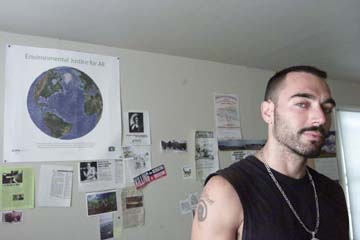The 2,000-acre patch of tall-grass prairie near Lake Benbrook that Jarid Manos took on as a cause four years ago still hasn’t been bought by environmental groups, turned into a park, or otherwise saved from development. But support for the park is still growing – not only among potential donors, according to Manos, but also from a TCU environmental sciences professor and a botanical institute with a worldwide reputation.
To Manos and others, the land, now owned by the state, is a window into Fort Worth’s ecological past, one of the last remaining tracts of North Texas Prairie large enough to constitute a natural ecosystem. But the effort to save it continues to be a bumpy road. Lack of support from the city and the Texas General Land Office’s firm $21 million price tag for the property, have both slowed down the process.
While still trying to find a way to protect the land in the long term, Manos and the GPRC have prevented potential degradation of the land in the short term. They successfully opposed a permit that would have allowed sewage waste to be dumped in the creek that runs through the area.
According to Manos, the land he refers to as Fort Worth Prairie Park contains as rich and diverse an ecosystem as any rain forest, boasting nearly 2,400 native plant species. Fort Worth, once known as Queen City of the Prairie, was built on top of 1.3 million acres of mostly grassland. Now, less than 60,000 of those acres remain as prairie, with a large portion of that land slated for development.
The Texas General Land Office, however, sees the parcel as an investment opportunity. The Southwest Parkway will occupy a swath of the property, and the land office expects development around the toll road to generate serious revenue for the state’s public schools.
Manos has bigger plans than just saving the prairie park. He wants to usher Fort Worth into the eco-city movement by connecting that land to other parks and trails. And though he hasn’t yet raised the money the land office wants for the property, the bulldozers are still at bay.
What he has done, he said, is to build a strong coalition of activists and organizers who continue to seek ways to protect the land through fund-raising and other conservation alternatives. Manos wouldn’t say how much he’s raised or who his financial partners are, only that he’s “making progress on several fronts.” He’s still in negotiations for specific dollar amounts of donations, he said, and many are waiting to see whether the downturn in the economy will affect the price of the land – though the Land Office has been very consistent on that point.
Manos believes that the base of support that he and his organization have built over the last four years is one reason the land has not been sold for development. “There are a lot more people involved,” he said. “There’s a strong constituency for it. There’s an agreement among environmentalists that it’s one of the rarest and largest remaining tracts of tall-grass native prairie left in the state of Texas.”
Progress toward a prairie park has been fraught with obstacles. In 2007, Land Commissioner Jerry Patterson gave Manos a year to prove that there was public support for the park concept. The Tarrant County Commissioners’ Court weighed in, pledging $1 million toward the purchase price.
In January 2007, in its usual “pre-council” informal session before a regular meeting, members of the Fort Worth City Council, including Mayor Mike Moncrief, expressed strong support for the park. When it came time to actually vote a few hours later, however, some council members and the mayor backed down, saying that the park might somehow conflict with the planned Southwest Parkway. But park supporters haven’t opposed the toll road and have actually made plans for wildlife underpasses and hiking trail overpasses in order to work around it.
The one-year deadline came and went. While the state agency did hold off on selling the land for that time period, a land office spokesman said the parcel is back on the market, though there are no current negotiations toward a sale.
The agency bought the land from an area rancher as an investment for the multi-billion-dollar Texas Permanent School Fund, which provides millions of dollars annually to help support Texas public schools. Administrators cannot legally give away a $21 million asset of the fund.
“Commissioner Patterson has gone out of his way to meet with [Manos], but he still has a responsibility to the school fund,” said agency spokesman Jim Suydam. “He could be impeached if he doesn’t uphold that responsibility.”
Still, it hasn’t all been closed doors and back-stabs for Manos. He successfully opposed a trailer park operator’s request for a permit to dump 10,000 gallons a day worth of treated sewage waste into Rock Creek, just above the point where the creek flows into the prairie. He and others convinced the operator to withdraw the permit.
“We won that battle,” Manos said. “They withdrew their application for permit. Rock Creek is one of the most pristine tributaries of the Clear Fork” of the Trinity River.
Wild Earth Guardians, a national wildlife and environmental group, recently found a rare species of mussel in Rock Creek and is trying to get it listed on the Texas Endangered Species list.
Currently, the land itself is being used as a teaching tool by a TCU professor, and plant life from the area is being used in a green roof project by the Botanical Research Institute of Texas.
The proposed park has the perfect dry, rocky communities of plants needed for the living roof on the new headquarters that BRIT is planning adjacent to the Fort Worth Botanical Gardens. Cleve Lancaster, a spokesperson for the institute, said that the swath of prairie is a showcase for plant groups native to the North Texas climate and therefore the best fit for BRIT’s plans. The roof will be covered by plants from a specific ecosystem called Fort Worth Prairie, characterized by the depth of the soil the plants grow in, the limestone layer underneath, and their adaptability to drought, flooding rains, and extreme temperatures.
“We recognized early on that we would have to do something suitable for this part of Texas,” Lancaster said. “Our roof is based on the Fort Worth Prairie. It’s been a three-year project … and it will be unique, as are the community of plants referred to as Fort Worth Prairie.”
TCU Prof. Tony Burgess, who teaches environmental studies, is advising BRIT on the best way to plant its green roof. He said that the prairie park has been valuable to him and his students because it is so accessible.
“For any biologist working in Texas, trying to get access to large pieces of land that begin to resemble natural ecosystems is pretty tough, and [the] prairie park provides it,” he said. “Most of the [remaining] Fort Worth prairie is in private hands … and a lot of the land is heavily ranched. To be able to get access to an area that was kept under the best possible conditions … and is only 20 minutes from TCU is a wonderful opportunity.”
Other big tracts remaining in the area are either less suitable or less open to researchers. Some of the best examples of surviving prairie in this area, Burgess said, belong to Ed Bass at his Winscott Ranch near Cresson. Warren Whittlesey, manager of Winscott, said that scientists have been allowed to conduct research on the property in the past, though it’s not common.
The Fort Worth Nature Center and Refuge, on the other hand, is more easily accessible, but doesn’t have the limestone base and therefore not the same ecosystem as typical Fort Worth prairie.
Burgess recognizes that turning the area into a park wouldn’t maximize its economic value.
“But,” he added, “How do you put a dollar amount on understanding of your natural heritage?”











